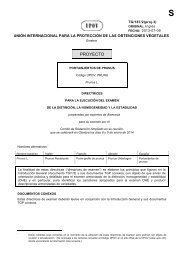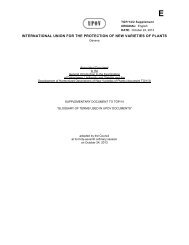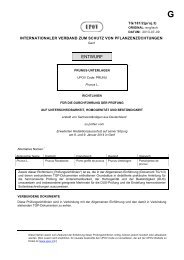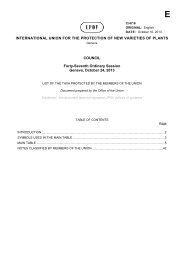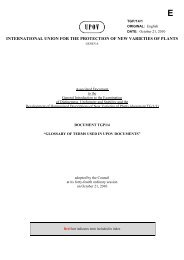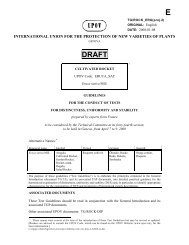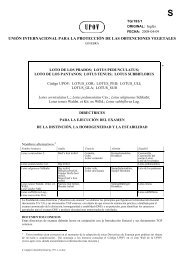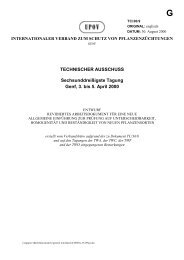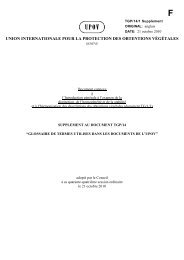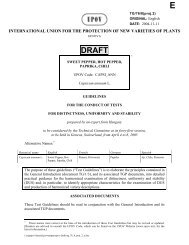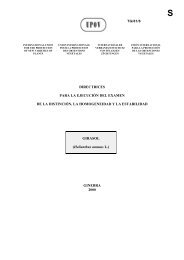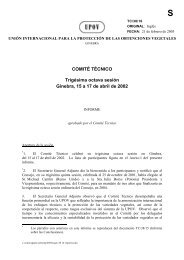E - International Union for the Protection of New Varieties of Plants
E - International Union for the Protection of New Varieties of Plants
E - International Union for the Protection of New Varieties of Plants
Create successful ePaper yourself
Turn your PDF publications into a flip-book with our unique Google optimized e-Paper software.
Ad. 23: Resistance to Verticillium sp. (Va and Vd)<br />
TG/TOM_ROOT(proj.4)<br />
Tomato Rootstocks, 2012-08-29<br />
- 17 -<br />
1. Pathogen ........................................ Verticillium dahliae or Verticillium albo-atrum (see note below)<br />
3. Host species .................................... Solanum lycopersicum<br />
4. Source <strong>of</strong> inoculum.......................... Naktuinbouw 3 (NL) and GEVES 4 (FR)<br />
5. Isolate .............................................. Race 0 (e.g. strain Toreilles 4-1-4-1)<br />
8. Multiplication inoculum<br />
8.1 Multiplication medium .................... Potato Dextrose Agar, Agar Medium “S” <strong>of</strong> Messiaen<br />
8.4 Inoculation medium........................ water (<strong>for</strong> scraping agar plates) or Czapek Dox broth (3-7 d-old<br />
aerated culture at 20-25°C, in darkness)<br />
8.6 Harvest <strong>of</strong> inoculum....................... filter through double muslin cloth<br />
8.7 Check <strong>of</strong> harvested inoculums…… spore count; adjust to 10 6 per ml<br />
8.8 Shelf life/viability inoculums…………1 d at 4°C<br />
9. Format <strong>of</strong> <strong>the</strong> test<br />
9.1 Number <strong>of</strong> plants per genotype…… 35 seed <strong>for</strong> 24 plants<br />
9.2 Number <strong>of</strong> replicates……………… Not applicable<br />
9.3 Control varieties<br />
Susceptible ……………………………… (Solanum lycopersicum) Flix, Marmande verte, Clarion, Santonio,<br />
Anabel<br />
Resistant ……………………………… . Big Power and (Solanum lycopersicum) Monalbo, Elias, Monalbo x<br />
Marmande verte, Daniela, Marmande VR<br />
9.4 Test design………………………… 20 plants inoculated at least, 2 blanks at least<br />
9.5 Test facility………………………… greenhouse or climate room<br />
9.6 Temperature………………………… optimal 20-25°C, 20-22°C after inoculation<br />
9.7 Light………………………………… 12 h or longer<br />
10. Inoculation<br />
10.1 Preparation inoculums…………… aerated, liquid culture (8.4)<br />
10.2 Quantification inoculums………… count spores, adjust to 10 6 per ml<br />
10.3 Plant stage at inoculation………… cotyledon to 3rd leaf<br />
10.4 Inoculation method……………… roots are immersed <strong>for</strong> 4 to 15 min in spore suspension.<br />
10.7 Final observations………………… 14-33 d after inoculation<br />
11. Observations<br />
11.1 Method……………………………… visual<br />
11.2 Observation scale………………… growth retardation, wilting, chlorosis, and vessel browning<br />
11.3 Validation <strong>of</strong> test………………… evaluation <strong>of</strong> variety resistance should be calibrated with results <strong>of</strong><br />
resistant and susceptible controls. Standards near borderline R/S<br />
will help to compare between laboratories.<br />
12. Interpretation <strong>of</strong> data in terms <strong>of</strong> UPOV characteristic states<br />
absent ………………………… [1] severe symptoms<br />
present ………………………… [9] mild or no symptoms<br />
13. Critical control points<br />
All symptoms may be present in resistant varieties, but <strong>the</strong> severity will be distinctly less than in susceptible<br />
varieties. Usually resistant varieties will show significantly less growth retardation <strong>the</strong>n susceptible varieties.<br />
Observation <strong>of</strong> vessel browning is important <strong>for</strong> diagnosis. Usually, vessel browning will not extend to <strong>the</strong> 1 st<br />
leaf in resistant varieties. Many hybrid varieties are heterozygous and appear to have mild symptoms in <strong>the</strong><br />
biotest. Such hybrids are still considered resistant.<br />
Note: Resistance to V. dahliae based in <strong>the</strong> Ve gene is also effective to V. albo-atrum. Isolates <strong>of</strong> both<br />
fungal species may be used to evaluate <strong>the</strong> UPOV characteristic “Resistance to V. dahliae” or V. albo-atrum<br />
as long as <strong>the</strong> isolate belongs to <strong>the</strong> non-Ve breaking race 0. Resistance-breaking isolates have been<br />
described in both species.<br />
3 Naktuinbouw: resistentie@naktuinbouw.nl<br />
4 GEVES; Valerie.GRIMAULT@geves.fr



